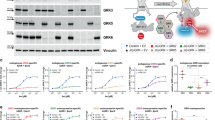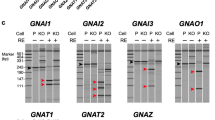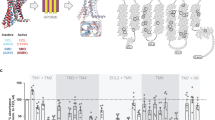Abstract
Tripartite G-protein-coupled receptors (GPCRs) represent one of the largest groups of signal transducers, transmitting signals from hormones, neuropeptides, odorants, food and light1,2. Ligand-bound receptors catalyse GDP/GTP exchange on the G-protein α-subunit (Gα), leading to α-GTP separation from the βγ subunits and pathway activation. Activating mutations in the receptors or G proteins underlie many human diseases, including some cancers, dwarfism and premature puberty. Regulators of G-protein signalling (RGS proteins) are known to modulate the level and duration of ligand-induced signalling by accelerating the intrinsic GTPase activity of the Gα subunit, and thus reformation of the inactive GDP-bound Gα3,4,5. Here we find that even in the absence of receptor, mutation of the RGS family member Sst2 (refs 6–9) permits spontaneous activation of the G-protein-coupled mating pathway in Saccharomyces cerevisiae at levels normally seen only in the presence of ligand. Our work demonstrates the occurence of spontaneous tripartite G-protein signalling in vivo and identifies a requirement for RGS proteins in preventing such receptor-independent activation.
This is a preview of subscription content, access via your institution
Access options
Subscribe to this journal
Receive 12 print issues and online access
$209.00 per year
only $17.42 per issue
Buy this article
- Purchase on Springer Link
- Instant access to full article PDF
Prices may be subject to local taxes which are calculated during checkout




Similar content being viewed by others
References
Farfel, Z., Bourne, H.R. & Iiri, T. The expanding spectrum of G protein diseases. N. Engl. J. Med. 340, 1012–1020 (1999).
Spiegel, A.M. Defects in G protein-coupled signal transduction in human disease. Annu. Rev. Physiol. 58, 143–170 (1996).
Berman, D.M., Wilkie, T.M. & Gilman, A.G. GAIP and RGS4 are GTPase-activating proteins for the Gi subfamily of G protein alpha subunits. Cell 86, 445–452 (1996).
Chen, C.K. et al. Slowed recovery of rod photoresponse in mice lacking the GTPase accelerating protein RGS9-1. Nature 403, 557–560 (2000).
Ross, E.M. & Wilkie, T.M. GTPase-activating proteins for heterotrimeric G proteins: regulators of G protein signaling (RGS) and RGS-like proteins. Annu. Rev. Biochem. 69, 795–827 (2000).
Chan, R.K. & Otte, C.A. Isolation and genetic analysis of Saccharomyces cerevisiae mutants supersensitive to G1 arrest by a factor and alpha factor pheromones. Mol. Cell. Biol. 2, 11–20 (1982).
Chan, R.K. & Otte, C.A. Physiological characterization of Saccharomyces cerevisiae mutants supersensitive to G1 arrest by a factor and alpha factor pheromones. Mol. Cell. Biol 2, 21–29 (1982).
Koelle, M.R. & Horvitz, H.R. EGL-10 regulates G protein signaling in the C. elegans nervous system and shares a conserved domain with many mammalian proteins. Cell 84, 115–125 (1996).
Druey, K.M., Blumer, K.J., Kang, V.H. & Kehrl, J.H. Inhibition of G-protein-mediated MAP kinase activation by a new mammalian gene family. Nature 379, 742–746 (1996).
Elion, E.A. Pheromone response, mating and cell biology. Curr. Opin. Microbiol. 3, 573–581 (2000).
Apanovitch, D.M., Slep, K.C., Sigler, P.B. & Dohlman, H.G. Sst2 is a GTPase-activating protein for Gpa1: purification and characterization of a cognate RGS-G alpha protein pair in yeast. Biochemistry 37, 4815–4822 (1998).
Dohmen, R.J., Wu, P. & Varshavsky, A. Heat-inducible degron: a method for constructing temperature-sensitive mutants. Science 263, 1273–1276 (1994).
Jenness, D.D. & Spatrick, P. Down regulation of the alpha-factor pheromone receptor in S. cerevisiae. Cell 46, 345–353 (1986).
Julius, D., Brake, A., Blair, L., Kunisawa, R. & Thorner, J. Isolation of the putative structural gene for the lysine-arginine-cleaving endopeptidase required for processing of yeast prepro-alpha-factor. Cell 37, 1075–1089 (1984).
Hartwell, L.H. Mutants of Saccharomyces cerevisiae unresponsive to cell division control by polypeptide mating hormone. J. Cell Biol. 85, 811–822 (1980).
Whiteway, M. et al. The STE4 and STE18 genes of yeast encode potential beta and gamma subunits of the mating factor receptor-coupled G protein. Cell 56, 467–477 (1989).
Perlman, R., Yablonski, D., Simchen, G. & Levitzki, A. Cloning of the STE5 gene of Saccharomyces cerevisiae as a suppressor of the mating defect of cdc25 temperature-sensitive mutants. Proc. Natl Acad. Sci. USA 90, 5474–5478 (1993).
Kraakman, L. et al. A Saccharomyces cerevisiae G-protein coupled receptor, Gpr1, is specifically required for glucose activation of the cAMP pathway during the transition to growth on glucose. Mol. Microbiol. 32, 1002–1012 (1999).
Dolan, J.W. & Fields, S. Cell-type-specific transcription in yeast. Biochim. Biophys. Acta 1088, 155–169 (1991).
Dohlman, H.G., Apaniesk, D., Chen, Y., Song, J. & Nusskern, D. Inhibition of G-protein signaling by dominant gain-of-function mutations in Sst2p, a pheromone desensitization factor in Saccharomyces cerevisiae. Mol. Cell Biol. 15, 3635–3643 (1995).
Mateus, C. & Avery, S.V. Destabilized green fluorescent protein for monitoring dynamic changes in yeast gene expression with flow cytometry. Yeast 16, 1313–1323 (2000).
Miller, R.T., Masters, S.B., Sullivan, K.A., Beiderman, B. & Bourne, H.R. A mutation that prevents GTP-dependent activation of the alpha chain of Gs. Nature 334, 712–715 (1988).
Stone, D.E. & Reed, S.I. G protein mutations that alter the pheromone response in Saccharomyces cerevisiae. Mol. Cell. Biol. 10, 4439–4446 (1990).
Dohlman, H.G., Song, J., Ma, D., Courchesne, W.E. & Thorner, J. Sst2, a negative regulator of pheromone signaling in the yeast Saccharomyces cerevisiae: expression, localization, and genetic interaction and physical association with Gpa1 (the G-protein alpha subunit). Mol. Cell Biol. 16, 5194–5209 (1996).
DiBello, P.R. et al. Selective uncoupling of RGS action by a single point mutation in the G protein alpha-subunit. J. Biol. Chem. 273, 5780–5784 (1998).
Pauwels, P.J. & Wurch, T. Review: amino acid domains involved in constitutive activation of G-protein-coupled receptors. Mol. Neurobiol. 17, 109–135 (2001).
Morisset, S. et al. High constitutive activity of native H3 receptors regulates histamine neurons in brain. Nature 408, 860–864 (2000).
Linder, M.E., Ewald, D.A., Miller, R.J. & Gilman, A.G. Purification and characterization of Go alpha and three types of Gi alpha after expression in Escherichia coli. J. Biol. Chem. 265, 8243–8251 (1990).
Graziano, M.P., Freissmuth, M. & Gilman, A.G. Expression of Gs alpha in Escherichia coli. Purification and properties of two forms of the protein. J. Biol. Chem. 264, 409–418 (1989).
Weiner, O.D., Servant, G., Parent, C.A., Devreotes, P.N. & Bourne, H.R. in Cell Polarity (ed. Drubin, D. G.) 201–239 (Oxford University Press, Oxford, 2000).
Acknowledgements
We thank J. Thorner for experimental advice, S. Avery for pSVA12 and 13, H. Dohlman for the Sst2 antibody and pGPA1G302S, I. Herskowitz for the HMLa HMRa strain, S. Reed and D. Stone for pGPA1G322E and R, C. Beh and J. Rine for the FUS1:GFP plasmid, J. Dohmen for pPW66R, and H. Nolla of the UC Berkeley Cancer Research Laboratory Flow Cytometry Facility for help with FACS. We thank C. Boone, H. Bourne, J. Rine, J. Thorner, M. Albers, K. Karbstein, K. Kozminski, G. Manning and the Drubin Laboratory for insightful discussions and comments on the manuscript. This work was supported by NIH grants GM20291 to D.E.S. and GM50399 to D.G.D.
Author information
Authors and Affiliations
Corresponding author
Ethics declarations
Competing interests
The authors declare no competing financial interests.
Supplementary information
Supplementary Figures and Table
Figure S1 Calibration of FACS data. (PDF 274 kb)
Supplementary table
Rights and permissions
About this article
Cite this article
Siekhaus, D., Drubin, D. Spontaneous receptor-independent heterotrimeric G-protein signalling in an RGS mutant. Nat Cell Biol 5, 231–235 (2003). https://doi.org/10.1038/ncb941
Received:
Revised:
Accepted:
Published:
Issue Date:
DOI: https://doi.org/10.1038/ncb941
This article is cited by
-
Negative feedback-loop mechanisms regulating HOG- and pheromone-MAPK signaling in yeast
Current Genetics (2020)
-
Fungal G-protein-coupled receptors: mediators of pathogenesis and targets for disease control
Nature Microbiology (2018)
-
A framework for mapping, visualisation and automatic model creation of signal‐transduction networks
Molecular Systems Biology (2012)
-
Transactivation joins multiple tracks to the ERK/MAPK cascade
Nature Reviews Molecular Cell Biology (2003)



